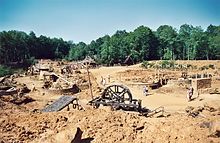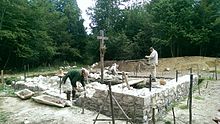Quarry stone (building material)



Quarry stone for buildings was and is still being quarried from the rock in the ground , usually in a quarry . He is not to be confused with the already loose naturally occurring scree , boulders or fieldstone used even with the art works or the building of houses and therefore proper form hewn stone .
Extraction
Quarry stones were originally only obtained through muscle power. Mallets, chisels, wedges and crowbars are used to break down the stones . The location of the quarry in relation to the construction site was chosen so that dismantling and transport were possible with the least possible effort. The natural rock layers were also used to extract stones that were as evenly shaped as possible. Quarry stones were usually only roughly trimmed with a hammer and cut into shape, only the visible surfaces were more or less smoothed. The transport to the construction site was carried out by carrying, pulling or dragging, but mostly with carts . Quarry stones were and are always gladly reused. When buildings are demolished, however, they are mostly crushed in crushers in recycling plants .
Advantages and disadvantages
Temperature compensation
In addition to its sustainable reusability, the often very strong quarry stone masonry stores heat and transfers it to the interior during the transition period. This creates a pleasant room climate, in hot summers the rooms stay cooler longer. Conversely, the walls cool down with long, low temperatures, so that the rooms become very cold, so it has to be heated strongly (previously mostly with tiled stoves ). Therefore, the rooms were usually well insulated with wooden block installations, wooden ceilings, wooden floors and paneling . In long, hot summers, the interiors heat up, but good ventilation or staying on the north side, which is remote from the sun, helps.
stability
The stability of quarry stone masonry depends on the wall thickness and is significantly influenced by the type of stone, the mortar bond, the stone size and shape and the subsoil . The corner stones are usually heavier and more precisely carved. Building stable quarry stone masonry requires a lot of experience and knowledge on the part of the bricklayer and carpenter . Cooperation with the carpenters used to be a matter of course, because the structures only got their necessary stability through the connection with the beam layers of the respective floors or the half-timbered structures. Both professions were coordinated. The builders often mastered both professions. The height of the structure is also decisive: the higher the quarry stone masonry, the more load-bearing or stronger the floor below must be built.
See also
literature
- Anton Behringer, Franz Rek: The book of masons. A specialist book for journeyman / foreman and foremen. A practical book for builders, architects and teachers. Otto Maier Verlag, 5th edition, Ravensburg 1951.